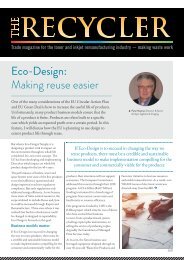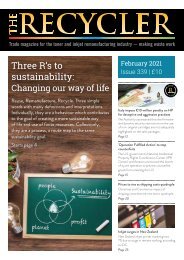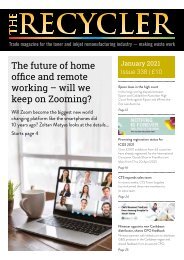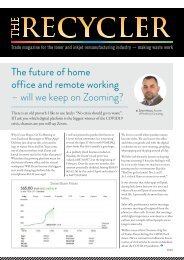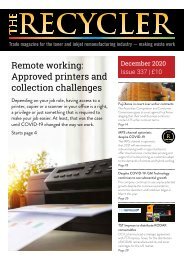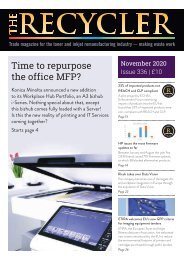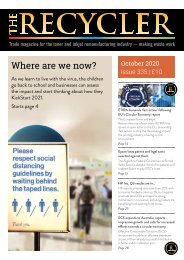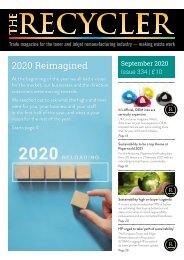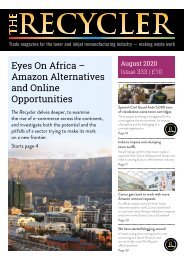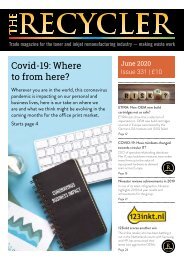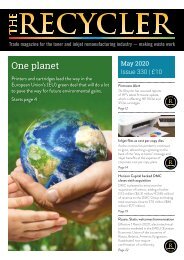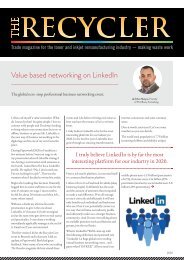Wide Format news 1-2017
Create successful ePaper yourself
Turn your PDF publications into a flip-book with our unique Google optimized e-Paper software.
it more practical in space. “Namely, faster speeds, increasing the<br />
range of materials, improving the integrity of printed parts, and<br />
making it easier to use. However, some things like ease of use<br />
are actually less important in space because the zero-G 3D printer<br />
is almost entirely remotely operated by experts. All the astronaut<br />
need do is say, ‘I need such and such’ and the ground teams will<br />
use the printer to make it so.”<br />
materials.”<br />
NASA/JPL is seeking partnerships with companies and<br />
universities to make new materials for 3D printing, which is a<br />
commercial development, Soderstrom added. There is quality<br />
assurance with materials to validate that the material will work.<br />
“One of the most interesting things is that when we send<br />
something into space, it’s extremely risky, so we demonstrate that<br />
it’s going to work as much as we can. So there is a lot of QA. We<br />
will x-ray the materials to assure there’s no problem with it.”<br />
Borgonia said that polymers are a good “show and tell” toy,<br />
but can 3D-printed titanium parts behave similar to the wrought<br />
version of the material? It’s something JPL is working with the<br />
America Makes Consortium to determine (so far, titanium does<br />
behave similarly).<br />
Dramatic innovation<br />
LavaHive, designed by the LavaHive team in the 3D Printed Habitat Challenge Design<br />
Competition, won third place in the NASA-awarded competition, using a ‘lava-casting’<br />
construction<br />
Changing methods<br />
An engineer designing a component of part with subtractive<br />
manufacturing is classically trained to understand how to do<br />
it, said John Paul Borgonia, Technologist at JPL Materials<br />
Developments and Manufacturing Technology Group.<br />
“There are some limitations to that type of manufacturing,”<br />
Borgonia said. “With additive, it completely changes their way<br />
of thinking as engineers, because there are features that would<br />
not have been possible to add to the hardware without additive<br />
manufacturing. Take, for example, I want a particular structure.<br />
Now, I want the actual inside of that structure to be cellular. With<br />
additive manufacturing, those features can be added.”<br />
In space, materials become important as it is super-hot and<br />
super-cold and airless, so they have to handle all that, Soderstrom<br />
noted. Now robots that fly, swim and climb are being made with<br />
more speed, in contrast to the delay in sending out plans and would<br />
take a week to come back. “This cycle that used to take weeks,<br />
now that we have the multi-material printer in house, that cycle<br />
that used to take six weeks is now a day and a half.”<br />
Soderstrom says innovative things are being done with 3D<br />
printing of food. One of his favourite devices is the “Star Trek”<br />
replicator. “How<br />
far away is that? It<br />
may not be that far.<br />
It all comes down<br />
to material, and I<br />
think being able to<br />
experiment with<br />
new materials is<br />
something that’s<br />
extremely important<br />
Jason Dunn, CTO of Made In Space (foreground) and Mike<br />
Snyder, Director of Research and Development (background) work<br />
on the 3D printer sent to operate in the microgravity of the<br />
International Space Station (courtesy of Made In Space)<br />
for us in space and<br />
here at JPL. We at<br />
JPL are working<br />
quite heavily now<br />
by looking at new<br />
Soderstrom says now, designs can be done over the internet with<br />
programmes through Thingiverse or similar websites, and with<br />
social networks, there is a collaboration that has never been done<br />
before. He says 3D printing is enabling us being on “the very cusp<br />
or dramatic innovation”. Kohlenberg says with the research efforts<br />
at Made In Space, they hope to expedite humanity’s ability to<br />
survive any potential future events that could jeopardise life on<br />
earth.<br />
“As we develop solutions for living sustainably in space, we<br />
can take those lessons of sustainability back to earth and better live<br />
on a planet with finite resources. In the very near term, we hope<br />
that our research leads to more products like Made In Space - Fibre<br />
On the right is the 3D printer by Made In Space launched to the International Space<br />
Station in 2014, and on the left is an electronics box that supplies power and stores data.<br />
The printer was deemed successful in 3D zero-gravity printing, and another larger 3D<br />
printer is currently at the ISS (courtesy of Made In Space)<br />
Optics with clear and tangible economic benefits that can further<br />
enable our long term vision.”<br />
Soderstrom says it’s about future thinking, with one of the<br />
key things considering how 3D printing can help NASA/JPL<br />
stakeholders - the public.<br />
“In fact, it’s all of humanity. Being able to engage the public<br />
and all of humanity in the idea of ‘What could we do with 3D<br />
printing?’ is one of the goals, and we’ve had quite a few of those<br />
already, but I think we’re just scratching the surface. All of the<br />
innovation that is happening in 3D printing in industry and homes<br />
throughout the world and in universities is really going to help us<br />
a lot.”<br />
©<strong>2017</strong> The Recycler www.therecycler.com Page 3





